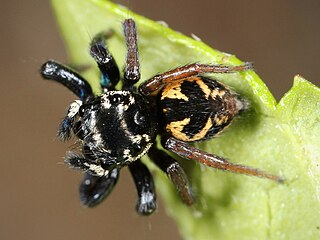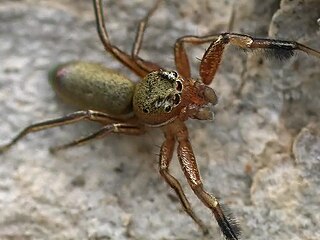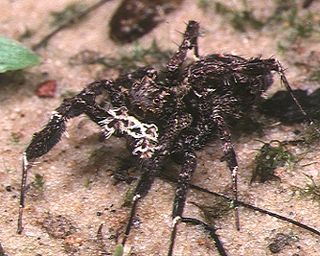
Habronattus is a genus in the family Salticidae. Most species are native to North America. They are commonly referred to as paradise spiders due to their colorful courtship ornaments and complex dances, similar to birds-of-paradise.

Anasaitis is a genus of jumping spiders that was first described by E. B. Bryant in 1950. The name is derived from the salticid genus Saitis.

Beata is a genus of jumping spiders that was first described by George Peckham & Elizabeth Peckham in 1895.

Chapoda is a genus of jumping spiders that was first described by George Peckham & Elizabeth Peckham in 1896.

Corythalia is a genus of jumping spiders that was first described by Carl Ludwig Koch in 1850.

Messua is a spider genus of the family Salticidae.

Neon is a spider genus of the jumping spider family, Salticidae. Its described species occur mostly in Eurasia, with some species found in North and South America. One species, N. convolutus, is also found in Algeria. Two species are known from Australia, N. australis and N. taylori. N. australis has palp morphology and fringing on its first pair of legs very similar to that seen in N. nojimai Ikeda 1995, from Japan. N. taylori is most similar in morphology to N. sumatranus from Indonesia and N. kovblyuki from the Crimea and elsewhere. The genus is common and widespread in litter throughout Australia, from the highlands of Tasmania through the hot, dry inland to the wet tropics and includes many undescribed species.

Pelegrina is a spider genus of the family Salticidae. They are found throughout North America. Many of the species in Pelegrina were previously placed in the genera Metaphidippus, and before that, Dendryphantes. The genus was originally described in 1930 by the Spanish arachnologist Pelegrín Franganillo Balboa, who named it after himself.

Sarinda is a genus of ant mimicking jumping spiders that was first described by George and Elizabeth Peckham in 1892.
Sidusa is a genus of jumping spiders that was first described by George and Elizabeth Peckham in 1895.

Terralonus is a genus of American jumping spiders that was first described by Wayne Paul Maddison in 1996.

Tutelina is a genus of jumping spiders that was first described by Eugène Louis Simon in 1901.

Zygoballus is a genus of jumping spiders found in North and South America.

The Spartaeinae are a subfamily of the spider family Salticidae. The subfamily was established by Fred R. Wanless in 1984 to include the groups Boetheae, Cocaleae, Lineae, Codeteae and Cyrbeae, which in turn were defined by Eugène Simon.
Galianora is a genus of Ecuadorian jumping spiders that was first described by Wayne Paul Maddison in 2006. As of June 2019 it contains only two species, found only in Ecuador: G. bryicola and G. sacha.

Zygoballus rufipes, commonly called the hammerjawed jumper, is a species of jumping spider which occurs in the United States, Canada, and Central America. Adult females are 4.3 to 6 mm in body length, while males are 3 to 4 mm.

Zygoballus incertus is a species of jumping spider which occurs in Panama.
Attinella is a genus of spiders in the family Salticidae.

Ghelna canadensis is a species of jumping spider in the family Salticidae. It is found in the United States and Canada.
















